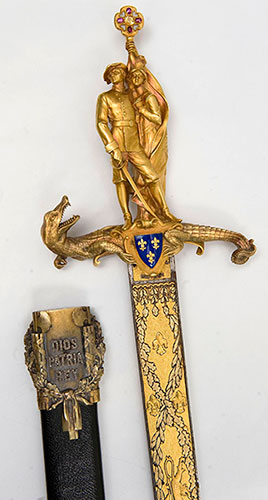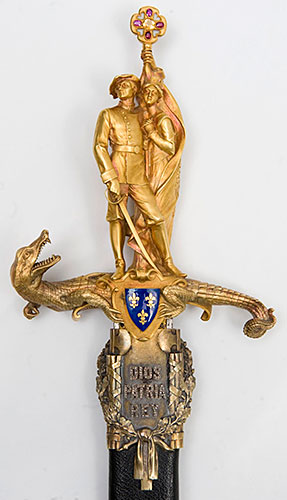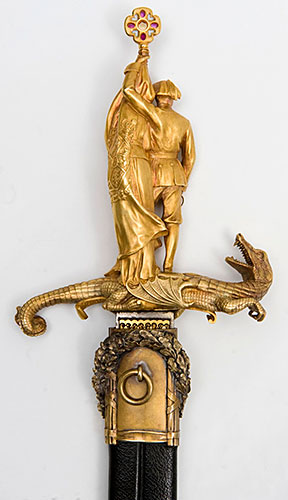The piece of the month of May 2019
A MODERNIST SWORD BY MASRIERA HERMANOS IN THE CARLIST MUSEUM OF ESTELLA
Ignacio Miguéliz Valcarlos
UNED Pamplona
The Museum of Carlism in Estella conserves and exhibits, on deposit from a private collection, the sword of honour that the Catalan Traditionalist Communion gave as a gift in 1911 to the Carlist pretender Jaime III (1870-1931). It is a sword with an iron blade richly ornamented with damascene work forming motifs of vegetal garlands that on the obverse inscribe, from top to bottom, the three bourbon fleurs-de-lis, a lion passing through, a Greek cross and the Latin registration , in Gothic script, "Triplici Agitatus Amore Ter Laedo". On the reverse, between the same subject of decoration and with the same spelling, is a phylactery with the registration "Anno Domini MCMX". Meanwhile, the hilt, made of fire-gilded bronze, is formed by an allegorical figurative representation, with a soldier and a woman on a dragon; the former forming the ear of corn and the latter the sparrowhawk. This iconography is a transposition of another iconography that has been very common in Catalonia throughout history, that of its patron saint, Saint George and the dragon. The male figure, of great bearing and a proud and confident gesture, is an allegory of a Carlist soldier, dressed in the uniform of the soldiers of Charles VII and wearing a beret, holding a sabre in one hand while the other holds a flag, in a gesture of protecting a female figure. This is none other than the allegory of Spain, with her hands joined in prayer and with a humble countenance, who, wearing a mural crown, is draped with the Spanish flag. At his feet, and on the dragon's back, are the arms of Don Jaime: a translucent enamel shield with the three fleurs-de-lis in gold on a blue background. The pole of the standard is surmounted by a Greek cross, articulated by means of floriated arms with brilliant-cut oval rubies, a square with a brilliant-cut citrine quartz and between the arms with figures of hearts in white translucent enamel, alluding to the cross of Saint George. On the field of the flag is the coat of arms of Spain: first quarter Castile, second Leon, third Aragon and fourth Navarre, with Granada and the Bourbon fleur-de-lis escutcheon in point, all of which is crowned with an imperial crown and surrounded by the collar of the Golden Fleece. It is striking that the allegorical figure is touched with a mural crown, which is common in Republican coats of arms, and not a royal crown, which is typical of the Spanish coat of arms. The scabbard is also preserved, made of black leather with a golden metal rim and ferrule; the first, of great development, has on the obverse side the Carlist emblem "Dios, Patria, Rey" (God, Fatherland, King) made with rose-cut diamonds, framed by two Roman fasces on which a crown of oak leaves is placed, and on the reverse side a ring for attaching to the belt. When the sword is placed in its scabbard, the coat of arms of the Bourbons remains above the Carlist emblem, forming a continuous whole.
Masriera Brothers and Eusebi Arnau. Sword of Honour of Jaume III. 1910.
Photo. Museum of Carlism. Estella.
After the death of Charles VII (1848-1909) and the proclamation of James III, the Catalan Jaumeists wanted to give him a sword of honour as a sign of his political significance and in memory of his participation in the Boxer War and the Russo-Japanese War, in which he fought in the ranks of the Russian army. This donation was recorded by Juan María Roma in the Álbum histórico del Carlismo, with a photograph of the hilt and a description of the sword:
The crossbar of the cross is formed entirely by a ferocious dragon, a symbol of destruction and death. Above this infernal dragon and forming the high arm of the cross are two figures: Spain, symbolised by a beautiful and severe matron dressed in a 15th-century tunic and crowned with castles, who fleeing from the demonic dragon seeks refuge in the soldier of Tradition, who in a gallant expectant attitude, his sabre at rest, wielded in his right hand, waves the flag of God, Fatherland and King with his left, and with it envelops Spain. The shield of Don Jaime, with the motto God, Country and King, and the three fleurs-de-lis, is framed by two Etruscan beams of the Roman lictors, symbol of authority, and a garland of oak leaves, representative of strength. On the reverse, a medallion with the dedication of the sword completes the ornamental motifs.
Analysis of the description allows us to verify that Roma did not have the sword in front of him when he made it, but rather a photo of it, since the Carlist motto "Dios, Patria, Rey" that quotation on the blade of the sword under the heraldic coat of arms of Don Jaime is not on the blade of the sword, as the photograph illustrating the description misleadingly leads us to believe, but on the scabbard.

Masriera Brothers and Eusebi Arnau. Sword of Honour of Jaume III. 1910.
Photo. Museum of Carlism. Estella.
Although at first the subscription to execute the sword was limited to Catalan Carlists, it was soon joined by supporters from all over Spain, as well as Spaniards living overseas. A commission presided over by Manuel de Llanza y Pignatelli de Aragón (1858-1927), Duke of Solferino and trusted confidant of Charles VII and later of James III, presented the sword to the pretender at his Austrian residency program , Frohsdorf Castle, on 15 January 1911. As Melchior Ferrer pointed out,
sample The Catalan Carlists wished to show their affection for the King by offering him a sword of honour, which was paid for by public subscription. The sketch, a marvellous work of art by the sculptor Eusebio Arnau, was justly praised. Tradition, symbolised by a soldier with a beret and sword in his hand, protects Spain and dominates the dragon at his feet. To do so submission, a commission travelled to Frohsdorf, presided over by the Duke of Solferino and composed of Don Pedro Vives, Don Bartolomé Trías, Don Octavio Domenech and Don J. Cabré. In the Hall of Honour, surrounded by his sister, the Infanta Archduchess Blanca, and her sons, Raniero and Leopoldo, Archdukes of Austria, and by the Count of Arbelaiz, Samaniego and José Joaquín de Olazábal, he received the sword, which the Duke of Solferino offered him with lively and heartfelt words of loyalty in the name of Catalonia. Don Jaime replied with a speech, thanking him for this manifestation of loyalty .....
As we can see, Don Jaime was accompanied on this workshop by his sister Doña Blanca (1868-1949), wife of Archduke Leopold of Austria Tuscany (1863-1931), and his nephews Archdukes Raniero (1895-1930) and Leopold (1897-1958) of Austria Tuscany and Bourbon, as well as Don Tirso de Olazábal y Lardizábal (1842-1921), Count of Arbelaiz y de Oria, gentleman of Don Jaime, Don José Joaquín de Olazábal y Álvarez de Eulate, son of the former, and Don Antero Samaniego y Martínez Fortún, secretary to the Pretender.
This was not the only weapon with damascene work that Don Jaime owned, as the Provincial Council of Bizkaia gave him a rifle with bayonet sabre in its velvet-lined mahogany case presentation , now in the Khalili collection, London. As stated on registration , this piece was made by Cariaga y C.a. in Ermua in 1876, when the prince was only six years old. The rifle was an exact scale copy of the one used by the King's Royal Guards Corps at the time. On this piece, along with inscriptions alluding to the maker and recipient of the gift, we also find the Carlist emblem of "God, Country and King", as on the scabbard of the sword preserved in Estella.

Masriera Brothers and Eusebi Arnau. Sword of Honour of Jaume III. 1910.
Photo. Museum of Carlism. Estella.
This sword bears several inscriptions of authorship, both on the blade and on the hilt. On the hilt we can see the mark of the Royal Artillery Factory of Toledo on the upper part, on the obverse, while on the hilt, on the hawk, on both sides of the coat of arms of Don Jaime are the inscriptions "MASRIERA HERMANOS", under the tail of the dragon, and "E. ARNAU", under the breast. Indeed, the blade of this sword was made in the Royal Artillery Factory of Toledo, as can be seen by the factory's mark on the upper part of the blade "Artillery (two crossed cannons surmounted by crown) Toledo Factory", a mark approved on 24 November 1906 and which remained in use until 7 April 1920. This factory was founded by Charles III in 1761 under the name of the Royal Sword Factory, and in 1783 it became part of the city's Artillery Corps, changing its name to the Toledo Artillery Factory. Among the pieces it made were numerous gala swords for army officers and swords of honour for gifts to soldiers or diplomats, as well as for sale. The factory's moments of splendour were experienced during the second half of the 19th century until the second decade of the following century. As for the damascene technique, although it is not known for sure when it was revived in Spain, it is probably related to the restoration of the armour of the Royal Armoury in Madrid carried out by Eusebio Zuloaga in the 1940s. Later Eusebio, accompanied by his son Plácido, settled in his native town of Eibar, where they founded a factory which from 1860 began to carry out work for the Toledo factory. Given the difficulty of moving the pieces from one place to another, the difficulty of attending to urgent orders and the existence of demand, in the 1970s a group of damascene artists established themselves final in Toledo. However, the modernist decoration based on vegetal elements on this piece is strange to the tradition of Toledo, where ornamentation in the Muslim tradition was more common, as well as Renaissance-style historicist motifs, which could indicate that the Casa Masriera, the maker of the hilt, probably sent the factory the design of the blade and the instructions for its manufacture. However, it was not taken into account where the factory's mark of authorship was to be engraved, as when the hilt was mounted, one of its decorative motifs, the heraldic coat of arms with the arms of Don Jaime, covered the mark.
As for the handle, it is from a design by the Catalan sculptor Eusebi Arnau for the Barcelona jewellers Masriera Hermanos. This establishment was one of the leading Catalan jewellers, and during Modernisme it was the jewellers who, in the words of Nuria Dalmases and Daniel Giralt-Miracle, brought "to Modernista jewellery the highest expression of its refinement, good taste and creative variety". The house was founded by Josep Masriera i Vidal (1810-1875), a silversmith who, coming from San Andrés de Llavaneras, settled in Barcelona in 1810. The workshop was continued by his two sons, Josep Masriera i Manovens (1841-1912) and Francesc Masriera i Manovens (1842-1902), who were also painters. Josep, who was to become one of the most important figures in the family, collaborated in the modelling of numerous works with the sculptor Manuel Fluxá, and was a landscape painter and researcher and a writer on artistic themes. Meanwhile, Francesc, also a silversmith and painter, travelled around Europe to learn about the technical and artistic innovations of other centres, studying the technique of enamelling and the engraving of fine stones in Geneva. Josep's son was Lluis Masriera i Rosés (1872-1958), one of the outstanding figures of modernist jewellery, the third generation of the family, and with whom Masriera Hermanos achieved universal renown. Encouraged by his father, he moved to Geneva to train as an enameller, a technique he perfected in Paris and London, incorporating on his return work of translucent and opaque enamel, the so-called "Barcelona enamel", along the lines of what René Lalique (1860-1945) was doing. A versatile man, he also devoted himself to painting and theatre, was director and founder of the magazine Estilo, vice-president of the Círculo Artístico de San Lluc, president of the association Artística de Joyería y Platería, and a member of the Academia de las Ciencias y las Artes de Barcelona, where in 1913 he gave the address speech "La caída del Modernismo", in which he declared that this style was now out of fashion, lamenting the ephemeral nature of its existence. As his father and uncle had done, Lluis Masriera collaborated with other artists to create his works, such as the sculptors Josep Llimona, Josep Reynes and Eusebi Arnau and the painters Alexandre de Rique and Apeles Mestres.

Masriera Brothers and Eusebi Arnau. Sword of Honour of Jaume III. 1910.
Photo. Museum of Carlism. Estella.
Thus, as we have pointed out, the handle of this piece is the result of Masriera Hermanos 's partnership with Eusebi Arnau i Mascort (1863-1933), a sculptor and medallist trained at the Barcelona School of Fine Arts. In 1887 he moved to Rome to continue his studies at programs of study, and later to Paris, where he exhibited his work in 1895 and 1902. One of his first pieces at partnership with a jeweller's shop was made with the Cabot silverware company in 1887, while the partnership with Masriera Hermanos for the manufacture of pieces dates from at least 1895. Arnau had a brilliant degree program which led him to make numerous medals and pieces of sculpture, both free-standing and created as decorative motifs for buildings constructed at the time, which led him to be recognised as one of the leading Catalan sculptors of Modernisme. His works include the design of a jewel with the image of Saint George and the dragon, topic , which he took up again in 1910 for the execution of this hilt, with which he won the silver medal in 1901 in the competition organised by the association Artística de Joyería y Platería de Barcelona to promote the creation of jewellery. Or the sculptures that adorned the façade of the Masriera and Campins Foundry, an establishment created by Víctor Masriera i Vila (1875-1938), son of Federico Masriera i Manovens and cousin of Lluis Masriera i Roses.
Paradoxically, four years before the sword was commissioned for the Carlist pretender, Masriera Hermanos had made the gift that the Catalan royalists gave Queen Victoria Eugenia de Battenberg (1887-1969) on the occasion of her betrothal to Alfonso XIII (1886-1931), a crown presented in an enamelled chest, one of the most ambitious creations of Catalan modernist goldsmiths. This fact attests to the fact that the choice of this house for this piece was not due to its links with the Carlist movement, but to the fact that it was one of the leading jewellers in Barcelona at the time.
SOURCES AND BIBLIOGRAPHY
Committed to History. Donaciones y depósitos en el Museo del Carlismo, Pamplona, Government of Navarre, 2014.
DALMASES, N., GIRALT-MIRACLE, D. and MANENT, R., Argenters i joiers de Catalunya, Barcelona, Destino, 1985.
El Correo Catalán, 25 July 1913.
FERRER, M., Historia del Tradicionalismo Español, Sevilla, publishing house Católica Española, 1960, Volume XXIX, p. 44.
LAVIN, J. D., El Arte y Tradición de los Zuloaga. Damasquinado español en la colección Khalili, Bilbao, Museo de Bellas Artes de Bilbao and The Khalili Family Trust, 2000.
MARÍN SILVESTRE, M.ª I., Eusebi Arnau Mascort, Barcelona, Infiesta publisher, 2006.
MELGAR, F., Don Jaime. El príncipe caballero, Madrid, Espasa Calpe, 1932.
MELGAR, F., El noble final de la escisión monárquica, Madrid, Gráficas Halar, 1964.
OCETE RUBIO, R. Armas blancas en España, Madrid, Tucán, 1988.
ROMA, J, M.ª, "Don Jaime de Borbón y Borbón, 2º duque de Madrid", in Álbum histórico del Carlismo, 1833 - 1933-35, Barcelona, Grafiques Ribera, 1935, Vol. 2, pp. 267-278.
SAN MARTÍN, J., LARRAÑAGA, R. and CELAYA, P., El damascene in Eibar, Eibar, board of trustees del Museo de Eibar, 1981.
SERRACLARA PLÁ, M.ª T., VILA TRAFACH, I. and RODRÍGUEZ PRAT, M., Lluis Masriera i Rosés, Pamplona, Caja Navarra, 2002.

